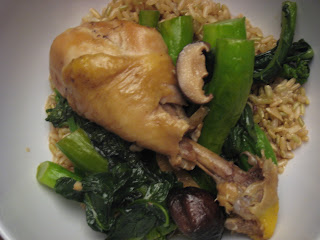We moved to a new apartment about six months ago, and this place was built for entertaining. However, finding time to make food for company on top of my full-time job and part-time class schedule is not the easiest. I've been hunting around the internet for some easy make-ahead recipes for entertaining, and I landed one day at the blog Dinner: A Love Story. Jenny and Andy post recipes that fit into a busy lifestyle, and Jenny is one of the co-authors of the book Time for Dinner and used to work at Real Simple, my favorite magazine. When they posted this recipe under the title "Instant Dinner Party", I was sold.
First, I had to get over my fear of talking to the butcher at my local store since there were only 8-pound pork shoulders out. I love my pork, but 8 pounds was really going to be too much. It turns out that he's really a very nice gentleman and cut down a roast to a more reasonable size for me. On the other hand, he doesn't know how many ounces there are in a pound, but maybe he's more used to the metric system?
Anyway, we'll have to have a group of people over to try this soon because it is ridiculously easy. Since the roast time is 3 to 4 hours but very little active cooking time is needed, this recipe is perfect for the weekend day you're home but not wanting to spend a lot of time cooking for company coming over later. For this first time, I tried it out on just the husband and one friend. I'm going to bet that my sister, who has been blogging up a storm, will be stealing this recipe very soon.
adapted from Dinner: A Love Story
2 to 2 1/2-pound boneless pork shoulder roast
salt and pepper
2 tablespoons olive oil
1 small pat butter
1 large can whole tomatoes, with juice
1 cup red wine
1 tablespoon dried thyme
1 tablespoon dried oregano
1 tablespoon hot sauce (optional)
Freshly grated Parmesan (optional)
2 to 2 1/2-pound boneless pork shoulder roast
salt and pepper
2 tablespoons olive oil
1 small pat butter
1 large can whole tomatoes, with juice
1 cup red wine
1 tablespoon dried thyme
1 tablespoon dried oregano
1 tablespoon hot sauce (optional)
Freshly grated Parmesan (optional)
1 to 2 lbs of cooked pasta (fettuccine used in picture)
Preheat oven to 325°F. Pat roast dry and then liberally salt and pepper all sides. Add olive oil and butter to large Dutch oven and heat over medium-high until butter melts. Add pork roast to pan and brown on all sides, about 8-10 minutes in all.
Preheat oven to 325°F. Pat roast dry and then liberally salt and pepper all sides. Add olive oil and butter to large Dutch oven and heat over medium-high until butter melts. Add pork roast to pan and brown on all sides, about 8-10 minutes in all.
Add tomatoes, wine, thyme, oregano, and hot sauce (if using). Cover, and put in oven. Braise for 3-4 hours, turning every hour or so. Add more liquid (water, wine, or tomato sauce) so that liquid comes to at least 1/3 of the way up the pork. Meat is done when it’s practically falling apart.
Pull pork apart with two forks. Serve over pasta with the grated Parmesan on the side.
Yields: 4 to 6 servings
Total time: About 4 to 4.5 hours
Active time: 30 minutes or less







